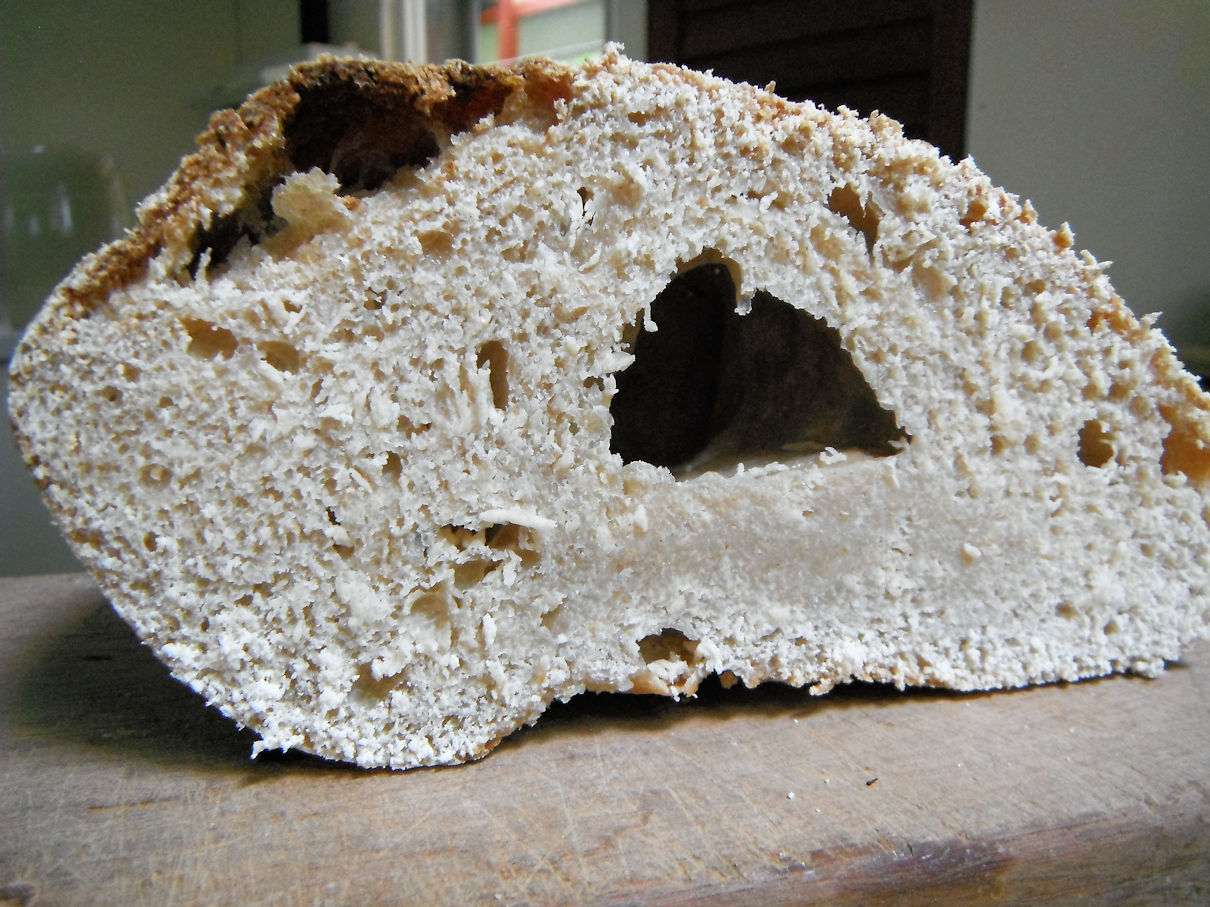The last two loaves I baked were a bit disappointing. I am satisfied with the texture overall, and the flavor too. I am disappointed they were riddled with huge holes, and a stodgy bit near the center.
I made a dough from a recipe of 20% wholemeal 80% white wheat. I had reserved 50ml water, but I cannot tell whether it is right, or needing a bit more, so I added the lot, adding up to 76% hydration. I air-kneeded it for 10 minutes, then stretch and folded it in the bowl four times over 2 hours, and a further 2 hours, total 4 1/2 hours approx bulk fermentation. My room temperature was only about 20C/ 68F. Then I turned the dough onto a bench lightly floured with rice flour, divided it into two, and formed round shapes. The surface of the doughs was smooth with rice flour so it didn't stick to my hands or bench. Then twenty minutes later I shaped them into boules and placed them in bannetons seam-side up. They went straight into the fridge until the morning 16 hours. In the morning I steamed my oven and removed the loaves from the banneton. I recall they were unusually small. I baked them seam-side down, in a steamed oven 230C/446F for twenty minutes, removed steam tray, baked a further 15minutes roughly. They were risen only average. What mistakes do you think I made? It is now winter in Australia, and I expected the overnight refrigeration would allow a final rise at 4C/ 39F.

Welcome to TFL!
There are a couple Aussie regulars here, who will hopefully chime in.
www.thefreshloaf.com/user/gavinc
and: www.thefreshloaf.com/user/yozzause
AU white flour is a peculiar animal in that (as I understand) it is not generally malted (or have added amylase), like most North American white (white meaning AP/bread) flours are. That's why I suggest their opinions, so they can find out if your particular white flour needs any additives.
--
Rice flour is not a particularly good choice for dusting your work surface when doing final shaping. It won't "dissolve" well (for lack of a better word) into the dough at that late stage. As you fold over the rice-flour-covered dough, the layer of rice flour can create seams inside the dough that might lead to the kind of cavern in the photo. It's okay to use rice flour to dust the banneton, as it will then stay on the outside. Though I personally prefer a 50/50 mix of white rice flour and regular white (AP/bread) flour for dusting bannetons.
--
The raw looking dough in the lower center makes me suspicious that you might also be having the same problem this fellow did: https://www.thefreshloaf.com/node/70754/oven-setup-evenly-baked-batards
Wherein my guess is that excess water/steam (at 100 C) might be cooling down his 210 C stone and causing the underside to be underbaked. See my comment there for a more in depth explanation.
--
Again, Welcome to the party!
Large ungainly holes: prevent by degassing the dough before the final rise. Some people think this is a bad thing. I say degassing contributes to a more desirable crumb with fewer monster holes and monster bubbles under the crust. And it doesn't get in the way of a nice open crumb.
Stodgy bottom: For me, this turned out to be a cold surface upon which I was fermenting. So depending on the type of dough(and my mood) I either fermented on a wood surface or used a heating pad under a few teatowels with the loaf rising as a freeform boule on a sheet pan or in a loaf pan.
I can't speak to this issue when using a Banneton I have only just made my bannetons and haven't had a chance to use them yet.
To me it looks very underfermented...
100% this is a fermentation issue.
Hi Josh and welcome to TFL. Can you give more detail on he wholemeal and white wheat, product names etc. Also, what was the levening, commercial yeast or sourdough? I think the dough was underfermented. Try and get your dough to around 24C in the initial mix and bulk ferment at around 24C.
Cheers,
Gavin
I'm with Ilya on this. If your room temp is truly 20C, then it probably is underfermented.
Rob
Definitely under fermented, depending on how much levain you used and whether it was very active or not, 20°C 4.5 hours of bulk fermentation sounds way to short. How much rise did the dough have at that point?
Benny
forgotten yeast. Could this be?